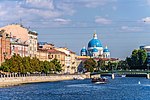Admiralty Shipyards
1704 establishments in RussiaCompanies nationalised by the Soviet UnionManufacturing companies based in Saint PetersburgShipbuilding companies of Imperial RussiaShipbuilding companies of the Soviet Union ... and 2 more
Ships built at Admiralty ShipyardUnited Shipbuilding Corporation

The JSC Admiralty Shipyards (Russian: Адмиралтейские верфи) (formerly Soviet Shipyard No. 194) is one of the oldest and largest shipyards in Russia, located in Saint Petersburg. The shipyard's building ways can accommodate ships of up to 70,000 tonnes deadweight (DWT), 250 metres (820 ft) in length and 35 metres (115 ft) in width. Military products include naval warships such as nuclear and diesel-powered submarines and large auxiliaries.
Excerpt from the Wikipedia article Admiralty Shipyards (License: CC BY-SA 3.0, Authors, Images).Admiralty Shipyards
набережная реки Фонтанки, Saint Petersburg
Geographical coordinates (GPS) Address Nearby Places Show on map
Geographical coordinates (GPS)
| Latitude | Longitude |
|---|---|
| N 59.919166666667 ° | E 30.2725 ° |
Address
набережная реки Фонтанки 203 литАС
190008 Saint Petersburg (Екатерингофский округ)
Saint Petersburg, Russia
Open on Google Maps









